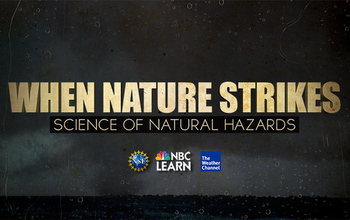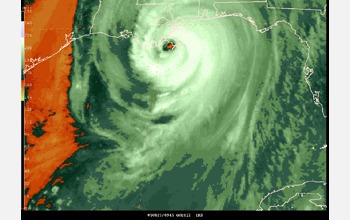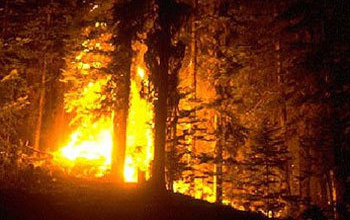All Images
News Release 15-119
NSF, NBC Learn and The Weather Channel showcase research to protect against nature's fury
Participate in Twitter chat #NatrlHazards to learn more
This material is available primarily for archival purposes. Telephone numbers or other contact information may be out of date; please see current contact information at media contacts.

NSF's Directorate for Geosciences, NBC Learn and the Weather Channel release a 10-part video series. Watch and learn about earthquakes, hurricanes, flash floods, landslides, space weather, tornadoes, tsunamis, wildfires and volcanoes.
Credit: NSF, NBC Learn
Download the high-resolution JPG version of the image. (166.8 KB)
Use your mouse to right-click (Mac users may need to Ctrl-click) the link above and choose the option that will save the file or target to your computer.

The peak winds of over 100 miles per hour that buffeted New Orleans, Louisiana, during Hurricane Katrina could have been much worse had the storm made landfall at a different moment in the cycle of its eyewall. Long-lived, intense hurricanes often go through an eyewall replacement cycle that takes a day or so to complete. The result is collapse of the main eyewall and temporary weakening of the storm. This water vapor band image shows Katrina's weakened eyewall being further disrupted by interaction with the land surface at 5:45 a.m. on Monday, Aug. 29, 2005.
Credit: Jeff Weber, a University Corporation for Atmospheric Research (UCAR) scientist, generated the image using GEMPAK software and data from the water vapor and infrared bands of the National Oceanic and Atmospheric Administration's (NOAA) GOES-E (Geostationary Operational Environmental) satellite.
Download the high-resolution JPG version of the image. (46.1 KB)
Use your mouse to right-click (Mac users may need to Ctrl-click) the link above and choose the option that will save the file or target to your computer.

A small explosion from Fuego, an open-vent volcano located 20 miles west of Guatemala City. Open-vent volcanoes constantly pop with small eruptions, causing low-level, low-frequency earthquakes but usually posing little risk. Scientists study these earthquakes to learn more about volcanic behavior and, ultimately, better ways to predict when a major eruption might occur.
Greg Waite, an assistant professor of geological and mining engineering and sciences at Michigan Technological University, is conducting his research on Fuego and Pacaya, another open-vent volcano just south of Guatemala City, under an NSF Faculty Early Career Development (CAREER) award. "We can apply what we learn about these small, repetitive events to other active volcanoes that are capable of large, damaging eruptions," Waite says. "We are trying to get a better handle on what these little earthquakes mean, so we can better forecast major eruptions."
Credit: NSF
Download the high-resolution JPG version of the image. (69.3 KB)
Use your mouse to right-click (Mac users may need to Ctrl-click) the link above and choose the option that will save the file or target to your computer.

On the afternoon of June 23, 2010, winds from the east began stirring up the Medano Fire in Sand Dunes National Park near Alamosa, Colorado, blowing smoke toward the dunes. The fire, which had consumed about 5,000 acres in a remote section of the park, was apparently started by lightning. Firefighters kept a close eye on the blaze but generally let it burn in the mountains since periodic fires are important for forest health. NCAR scientists are studying wildfires to forecast fire-weather interactions, assess emissions, and understand the social impacts. NCAR is sponsored by the National Science Foundation.
Credit: David Hosansky, NCAR
Download the high-resolution JPG version of the image. (28.8 KB)
Use your mouse to right-click (Mac users may need to Ctrl-click) the link above and choose the option that will save the file or target to your computer.


